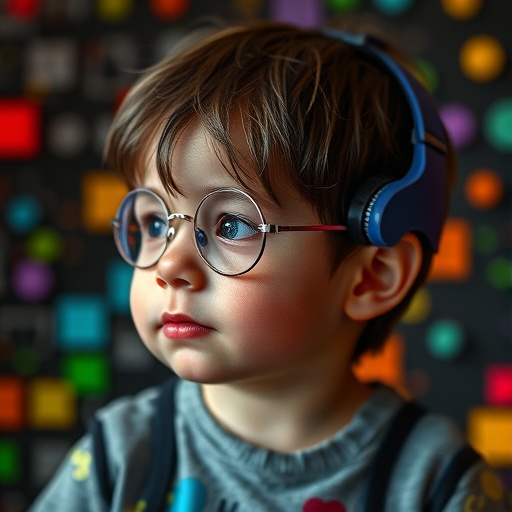In a groundbreaking study that sheds light on the cognitive abilities of autistic children, researchers have established that these individuals possess intact audiovisual spatial integration capabilities. This study, led by Vassall and Wallace and published in the Journal of Autism and Developmental Disorders in 2025, introduces compelling evidence that challenges preconceived notions about the sensory processing abilities of those on the autism spectrum.
The significance of this research lies in its focus on how autistic children integrate audiovisual cues in their surroundings—an area that has received limited attention in past studies. The traditional perspective often depicted autistic individuals as having deficits in sensory integration, leading to a generalized assumption that children with autism struggle to synthesize information from multiple sensory channels. However, Vassall and Wallace’s findings argue otherwise.
Drawing upon a diverse pool of participants, the authors meticulously designed experiments that monitored both auditory and visual stimuli and their interaction in autistic children. These experiments revealed a surprising resilience in how these children processed audiovisual information. Specifically, the participants demonstrated a remarkable ability to accomplish tasks requiring them to effectively coordinate and integrate sounds with visual cues. This challenges the long-held perceptions and suggests a nuanced understanding of the sensory capabilities inherent in autistic children.
Moreover, the implications of this research extend beyond academic discourse. By showcasing the intact audiovisual integration, this study encourages a re-evaluation of educational approaches and interventions aimed at autistic individuals. If these children can flawlessly integrate sensory information, there may be a need for tailored strategies that build on these strengths rather than focusing solely on perceived deficits.
The methodology employed in this study is equally noteworthy. Utilizing a combination of behavioral tests and advanced neuroimaging techniques, Vassall and Wallace were able to objectively quantify the children’s responses to audiovisual stimuli. This data not only underscores the competence of autistic children in integrating sensory information but also provides insights into the neurological underpinnings associated with such processes.
Crucially, the study elaborates on the brain regions involved in audiovisual integration. Researchers identified activation patterns that indicated efficient communication between auditory and visual processing areas of the brain in autistic children. This discovery raises intriguing questions regarding the neural architecture of sensory integration and suggests that there may be other cognitive strengths that are often overshadowed by behavioral characteristics.
Despite the promising results, the authors caution against generalizing these findings to all individuals on the autism spectrum. Autism is highly heterogeneous, and while some children may show robust audiovisual integration, others may present varied profiles. This study ultimately highlights the importance of individualized assessments, encouraging educators, parents, and clinicians to recognize and nurture each child’s unique abilities.
Moreover, this research spurs further investigations into the potential applications of these findings. This research could pave the way for more inclusive learning environments that capitalize on the strengths of autistic children. Educators and policymakers are urged to revisit existing frameworks for pedagogical practices, integrating the concept of sensory integration into curricula that accommodate diverse learning styles.
Philosophically, the study emphasizes a transformative approach to viewing autism—not merely as a collection of challenges but as a spectrum of intricate abilities worthy of exploration. This shift in perspective aligns with broader movements advocating for neurodiversity, promoting the idea that different cognitive experiences should be celebrated rather than pathologized.
In addition, contemporary discussions about autism often touch on the societal implications of such research. By delineating the intact features of sensory processing in autistic children, the study encourages a cultural re-evaluation of autism. It invites society to reflect on its biases regarding autistic capabilities, urging a more nuanced engagement with the autistic community that prioritizes their perspectives and experiences.
As the dialogue surrounding autism evolves, research like Vassall and Wallace’s serves as a reminder of collective responsibility. There is a growing imperative to ensure that autistic voices contribute to narratives about their own experiences. The importance of advocacy and the incorporation of autistic viewpoints into educational policies cannot be understated.
In conclusion, Vassall and Wallace’s study on intact audiovisual spatial integration in autistic children is a pivotal contribution to the field of autism research. It not only challenges existing paradigms but also encourages future inquiries that could deepen our understanding of the complexities surrounding autism. By embracing a more holistic view of sensory integration, there is potential to uncover further strengths amidst the diversity of autistic experiences. This work holds promise for empowering autistic individuals and fostering a more inclusive society that recognizes and celebrates their varied capabilities.
As we explore the ramifications of this work, one thing becomes abundantly clear: the intricacies of the human brain, particularly in autistic individuals, offer endless opportunities for discovery and growth. This potential for integrating insights into education and community practices speaks to the need for continued research and advocacy to foster understanding and support for all neurodiverse individuals.
Subject of Research: Intact Audiovisual Spatial Integration in Autistic Children
Article Title: Intact Audiovisual Spatial Integration in Autistic Children
Article References:
Vassall, S.G., Wallace, M.T. Intact Audiovisual Spatial Integration in Autistic Children.
J Autism Dev Disord (2025). https://doi.org/10.1007/s10803-025-07124-z
Image Credits: AI Generated
DOI: https://doi.org/10.1007/s10803-025-07124-z
Keywords: Autism, Audiovisual Integration, Sensory Processing, Neurodiversity, Children, Cognitive Abilities.
Tags: audiovisual integration in autismauditory visual cue coordinationautistic children sensory processingchallenges to autism stereotypescognitive abilities of autistic childrengroundbreaking autism research findingsJournal of Autism and Developmental Disordersmultisensory processing in childrenresearch on autism spectrumsensory integration skills in autismunderstanding autism sensory capabilitiesVassall and Wallace study





